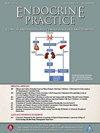碘与甲亢:一把双刃剑
IF 3.7
3区 医学
Q2 ENDOCRINOLOGY & METABOLISM
引用次数: 0
摘要
碘是一种存在于地壳中的微量元素,是甲状腺激素生物合成所必需的。由于正常的平衡机制失效,过量的碘暴露会导致甲状腺功能亢进。碘诱发的甲状腺机能亢进症最常发生在历史上缺碘的地区,这些地区甲状腺自主功能结节的发病率较高,但这种情况也可能发生在背景碘摄入量最佳的地区。碘过量的潜在来源包括碘盐、海藻、含碘补充剂、饮用水、含碘造影剂和胺碘酮。无机碘除了是甲状腺机能亢进症的潜在病因外,还可用于治疗巴塞杜氏甲状腺机能亢进症和甲状腺风暴,但有可能加重某些患者的甲状腺机能亢进症。无机碘还可用于术前治疗,在甲状腺切除术前减少甲状腺血管。认识到碘的潜在来源以及特别容易受到碘过量影响的患者,有助于识别和预防甲状腺功能亢进症。本文是对布拉夫曼和罗蒂1995年发表在《内分泌实践》创刊号上的一篇综述的更新。本文章由计算机程序翻译,如有差异,请以英文原文为准。
Iodine and Hyperthyroidism: A Double-Edged Sword
Objective
This article serves as an update to a 1995 review by Braverman and Roti that was publishsed in the inaugural issue of Endocrine Practice.
Methods
We searched PubMed for relevant English-language literature and identified additional papers cited in recent reviews.
Results
Iodine is a trace element found in the Earth’s crust that is necessary for the biosynthesis of thyroid hormones. Excessive iodine exposure can lead to hyperthyroidism due to the failure of normal homeostatic mechanisms. Iodine-induced hyperthyroidism occurs most frequently in historically iodine-deficient regions, where there is an increased prevalence of autonomously functioning thyroid nodules, but this can also occur in regions with optimal background iodine intakes. Potential sources of iodine excess include iodized salt, seaweed, iodine-containing supplements, drinking water, iodinated contrast media, and amiodarone. In addition to being a potential cause of hyperthyroidism, inorganic iodine may be used to treat Graves’ hyperthyroidism and thyroid storm, although there is a risk that this may worsen hyperthyroidism in some patients. Inorganic iodine is also used as a preoperative treatment to reduce thyroid vascularity before thyroidectomy.
Conclusion
Recognizing potential sources of iodine and patients who may be particularly vulnerable to the effects of iodine excess can help to identify and prevent hyperthyroidism.
求助全文
通过发布文献求助,成功后即可免费获取论文全文。
去求助
来源期刊

Endocrine Practice
ENDOCRINOLOGY & METABOLISM-
CiteScore
7.60
自引率
2.40%
发文量
546
审稿时长
41 days
期刊介绍:
Endocrine Practice (ISSN: 1530-891X), a peer-reviewed journal published twelve times a year, is the official journal of the American Association of Clinical Endocrinologists (AACE). The primary mission of Endocrine Practice is to enhance the health care of patients with endocrine diseases through continuing education of practicing endocrinologists.
 求助内容:
求助内容: 应助结果提醒方式:
应助结果提醒方式:


